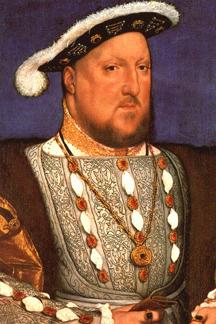

Henry VIII
King of England, Ireland and France |
|
The five Tudor
Monarchs are:
 |
|
|
Henry VIII (June 28, 1491- January 28, 1547) was King of England
from April 22 (crowned on June 24), 1509 until his death on January 28,
1547. He became King of Ireland in 1541, having reigned as Lord of Ireland
previously.
He was the second son of King Henry VII and Elizabeth of York.He was
created Prince of Wales after the death of his older brother Arthur Tudor.
A dispensation from the Pope was necessary in order to allow him to marry
his brother's widow Catherine of Aragon, and this was obtained on the basis
of non-consummation. Following difficulties with Rome over his divorce
from Catherine (which was not sanctioned by the Pope, who was under pressure
from Catherine's nephew, Charles V at the time), Henry split from the Roman
Catholic Church, seized many of the Church's assets, and formed the Church
of England. This became final with the passing of the Act of Supremacy
1536.
During 1513Thomas Howard, Third Duke of Norfolk, defeated the invasion
attempt of James IV of Scotland at Flodden during Henry's absence at war
against France. Henry's long rivalry with King Francis I of France was
made more serious by the cooperation between France and Scotland, both
Catholic countries. Henry and Francis had met at the Field of the Cloth
of Gold in 1520. Peace with France was finally concluded in 1546.
Henry VIII greatly improved English seapower and instituted an efficient
navy. His flagship, the Mary Rose, sank in the Solent during a battle,
and its retrieval during the 1980s provided valuable archaeological evidence
about the period. It is now on display at Portsmouth.
Throughout his life he was an avid gambler playing at dice, tables and
cards. It is claimed by some that he was playing Primero at the time of
Elizabeth's birth. Other card games played by Henry include cent, Imperial
and Pope Julius.
The other major achievement of Henry's reign was the Act of Union of
1536, which effectively brought Wales under English government, with the
result that the first Welsh members of parliament were elected in 1542.
Henry was proud of his own Welsh blood.
Henry is also famous for his six wives. After divorcing Catherine of
Aragon, he married Anne Boleyn on January 25, 1533. While Anne bore Henry
a female child Elizabeth, she did not give him the male heir he so desperately
wanted. For this reason he had her executed on trumped up charges of adultery
and married Jane Seymour. Seymour gave Henry a male child, but she died
shortly after doing so. The boy was sickly, and Henry reluctantly remarried,
on the advice of his chancellor, Thomas Cromwell. Cromwell, like his predecessors,
More and Wolsey, fell from favour and was charged with treason.
His fourth wife was the German Protestant Anne of Cleves. Henry disliked
her from the beginning, and had their marriage annulled after only a few
months. He proceeded to marry Catherine Howard, a young cousin of Anne
Boleyn, who, like Anne, was found guilty of adultery and executed for treason.
His last wife was Catherine Parr, a more mature woman who had been twice
widowed. None of his last three queens bore him any children. A mnemonic
to remember the fates of his six queens is "Divorced, beheaded, died; divorced,
beheaded, survived."
It is well known that, in later life, Henry was grossly overweight,
and possibly suffered from both gout and syphilis. In his younger days,
however, he had been a very active man. His increased size dates from a
jousting accident in 1536. He suffered a thigh wound which not only prevented
him from taking exercise but which gradually became ulcerated and may have
indirectly led to his death. Henry died in 1547 at Whitehall in London
and was buried at Windsor. At his death he left three children, each of
whom had a turn on the English throne: Edward VI, Mary I, and Elizabeth
I.
Also see the notes on Thomas Abel, Thomas Cardinal Wolsey, Sir Thomas
More, John Fisher, Bishop of Rochester, Thomas Howard Duke of Norfolk
There have been been many films about Henry VIII and his court. Two
that bear mention here are the 1933 The Private Life of Henry VIII
starring Charles Laughton and the 1972 The Six Wives of Henry VIII
starring Keith Michell.
The Henry VIII and his wives' "Relationship Matrix":
|
relationships
|
Henry VIII
|
Catherine of Aragon
|
Anne Boleyn
|
Jane Seymour
|
Anne of Cleves
|
Katherine Howard
|
Catherine Parr
|
|
Henry VIII
|
|
half 3C1R
|
5C1R
|
5C
|
5C
|
5C1R
|
3C1R
|
|
Catherine of Aragon
|
half 3C1R
|
self
|
6C1R
|
4C3R
|
5C1R
|
6C1R
|
half 3C2R
|
|
Anne Boleyn
|
5C1R
|
6C1R
|
self
|
half 2C
|
8C1R
|
1C
|
4C1R
|
|
Jane Seymour
|
5C
|
4C3R
|
half 2C
|
self
|
7C1R
|
half 2C
|
5C1R
|
|
Anne of Cleves
|
5C
|
5C1R
|
8C1R
|
7C1R
|
self
|
8C1R
|
7C
|
|
Katherine Howard
|
5C1R
|
6C1R
|
1C
|
half 2C
|
8C1R
|
self
|
6C
|
|
Catherine Parr
|
3C1R
|
half 3C2R
|
4C1R
|
5C1R
|
7C
|
6C
|
self
|
Key: C = cousin; R = removed; Example: 2C1R = 2nd cousin once
removed
This article is licensed under the GNU Free Documentation
License, which means that you can copy and modify it as long as the entire
work (including additions) remains under this license. See http://www.gnu.org/copyleft/fdl.html
for details. It uses material from the Wikipedia article Henry_VIII_of_England